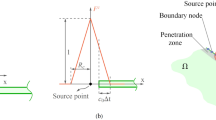Abstract
In this paper, we present the formulation of a time-domain impedance boundary model based on a finite-point approximation. Firstly, the scalar wave equation is numerically treated studying either the stability or the dispersion error in the case of a Cartesian regular mesh with standard clouds and weighted functions. Then, we develop the formulation of a locally reacting impedance boundary model suitable for the whole acoustic impedance range, and we carried out several numerical experiments to confirm the accuracy and the performance of the full model. Lastly, some conclusions and remarks of the method are discussed.




Similar content being viewed by others
References
Kutruff H (2000) Room acoustics, 4th edn. Spon Press, London
Botteldooren D (1995) Finite-difference time-domain simulation of low-frequency room acoustic problems. J Acoust Soc Am 98:3302–3308
Kowalczyk K, van Walstijn M (2011) Room acoustics simulation using 3-D compact explicit FDTD schemes. IEEE Trans Audio Speech Lang Process 19(1):34–46
Murphy DT, Beeson M (2007) The KW-boundary hybrid digital waveguide mesh for room acoustics applications. IEEE Trans Audio Speech Lang Process 15(2):552–564
Spa C, Garriga A, Escolano J (2010) Impedance boundary conditions for pseudo-spectral time-domain methods in room acoustics. Appl Acoust 71(5):402–410
Spa C, Escolano J, Garriga A (2011) Semi-empirical boundary conditions for the linearized acoustic Euler equations using pseudo-spectral time-domain methods. Appl Acoust 72(4):226–230
Murphy D, Southern A, Savioja L (2014) Source excitation strategies for obtaining impulse responses in finite difference time domain room acoustics simulation. Appl Acoust 82:6–14
Botts J, Savioja L (2014) Effects of sources on time-domain finite difference models. J Acoust Soc Am 136(1):242–247
Botts J, Savioja L (2014) Spectral and pseudospectral properties of finite difference models used in audio and room acoustics. IEEE Trans Audio Speech Lang Process 22(9):1403–1412
Escolano J, Spa C, Garriga A, Mateos T (2013) Removal of afterglow effects in 2-D discrete-time room acoustics simulations. Appl Acoust 74(6):818–822
Southern A, Siltanen S, Murphy DT (2013) Room impulse response synthesis and validation using a hybrid acoustic model. IEEE Trans Audio Speech Lang Process 21(9):1940–1952
Bilbao S (2013) Modeling of complex geometries and boundary conditions in finite difference/finite volume time domain room acoustics simulation. IEEE Trans Audio Speech Lang Process 21(7):1524–1533
Jensen P (1972) Finite difference technique for variable grids. Comput Struct 2:17–29
Perrone N, Kao R (1975) A general finite difference method for arbitrary meshes. Comput Struct 5(1):45–57
Liszka T, Orkisz J (1980) The finite difference method at arbitrary irregular grids and its application in applied mechanics. Comput Struct 11(1–2):83–95
Belytschko T, Krongauz Y, Organ D, Fleming M, Krysl P (1996) Meshless methods: an overview and recent developments. Comput Methods Appl Mech Eng 139:3–47
Li S, Liu WK (2004) Meshfree particle methods. Springer, Berlin
Gu YT (2005) Meshfree methods and their comparisons. Int J Comput Methods 4:477–515
Chen Y, Lee J, Eskandarian A (2006) Meshless methods in solids mechanics. Springer, Berlin
Oñate E, Idelsohn S, Zienkiewics OC, Taylor RL, Sacco C (1996) A stabilized finite point method for analysis of fluid mechanics problems. Comput Methods Appl Mech Eng 139:315–346
Oñate E, Idelsohn S, Zienkiewicz OC, Taylor RL (1996) A finite point methods in computational mechanics, application to convective transport and fluid flow. Int J Numer Methods Eng 39:3839–3866
Ortega E, Oñate E, Idelsohn S (2007) An improved finite point method for three-dimensional potential flows. Comput Mech 40:949–963
Taylor RL, Idelsohn S, Zienkiewicz OC, Oñate E (1995) Moving least square approximations for solution of differential equations. CIMNE research report 74
Pérez L, Perazzo F, Angulo A (2009) A meshless FPM model for solving nonlinear material problems with proportional loading based on deformation theory. Adv Eng Softw 40(11):1148–1154
Pérez L, Meneses R, Spa C, Durán O (2012) A meshless finite-point approximation for solving the RLW equation. Math Probl Eng, Article ID 802414
Pérez L, Campos A, Lascano S, Oller S, Rodríguez-Ferran A (2014) A finite points method approach for strain localization using the gradient plasticity formulation. Math Probl Eng, Article ID 782079
Kelloniemi A, Savioja L, Välimäki V (2005) Spatial filter-based absorbing boundary for the 2-D digital waveguide mesh. IEEE Signal Process Lett 12(2):1269
Acknowledgements
The work of the authors is partially funded by Projects FONDECYT 11140212 (Chile), Advanced Center for Electrical and Electronic Engineering (AC3E) Basal Project FB0008 (Chile) and the European Unions Horizon 2020 research and innovation programme under the Marie Sklodowska-Curie Grant Agreement No. 644602.
Author information
Authors and Affiliations
Corresponding author
Ethics declarations
Conflicts of interest
The author(s) declare(s) that there is no conflict of interest regarding the publication of this paper.
Additional information
Technical Editor: Jader Barbosa Jr.
Rights and permissions
About this article
Cite this article
Spa, C., Rivas, R. & Pérez, L. Impedance boundary conditions for a time-domain finite-point method. J Braz. Soc. Mech. Sci. Eng. 40, 324 (2018). https://doi.org/10.1007/s40430-018-1247-9
Received:
Accepted:
Published:
DOI: https://doi.org/10.1007/s40430-018-1247-9




